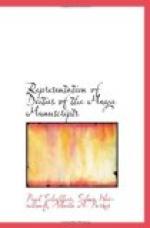Warmest thanks are above all due to Mr. Bowditch, of Boston, who in the most disinterested manner, for the good of science, has made possible the publication of this new edition.
January, 1904. P. Schellhas.
THE MATERIAL OF THE MANUSCRIPTS.
The three manuscripts which we possess of the ancient Maya peoples of Central America, the Dresden (Dr.), the Madrid (Tro.-Cort.) and the Paris (Per.) manuscripts, all contain a series of pictorial representations of human figures, which, beyond question, should be regarded as figures of gods. Together with these are a number of animal figures, some with human bodies, dress and armor, which likewise have a mythologic significance.
The contents of the three manuscripts, which undoubtedly pertain to the calendar system and to the computation of time in their relation to the Maya pantheon and to certain religious and domestic functions, admit of the conclusion, that these figures of gods embody the essential part of the religious conceptions of the Maya peoples in a tolerably complete form. For here we have the entire ritual year, the whole chronology with its mythological relations and all accessories. In addition to this, essentially the same figures recur in all three manuscripts. Their number is not especially large. There are about fifteen figures of gods in human form and about half as many in animal form. At first we were inclined to believe that further researches would considerably increase the number of deities, but this assumption was incorrect. After years of study of the subject and repeated examination of the results of research, it may be regarded as positively proved, that the number of deities represented in the Maya manuscripts does not exceed substantially the limits mentioned above. The principal deities are determined beyond question.
The way in which this was accomplished is strikingly simple. It amounts essentially to that which in ordinary life we call “memory of persons” and follows almost naturally from a careful study of the manuscripts. For, by frequently looking attentively at the representations, one learns by degrees to recognize promptly similar and familiar figures of gods, by the characteristic impression they make as a whole, or by certain details, even when the pictures are partly obliterated or exhibit variations, and the same is true of the accompanying hieroglyphs. A purely inductive, natural science-method has thus been followed, and hence this pamphlet is devoted simply to descriptions and to the amassing of material. These figures have been taken separately out of the manuscripts alone, identified and described with the studious avoidance of all unreliable, misleading accounts and of all presumptive analogies with supposedly allied mythologies.
Whatever cannot be derived from the manuscripts themselves has been wholly ignored. Hypotheses and deductions have been avoided as far as possible. Only where the interpretation, or the resemblance and the relations to kindred mythologic domains were obvious, and where the accounts agreed beyond question, has notice been taken of the fact so that the imposed limitations of this work should not result in one-sidedness.




